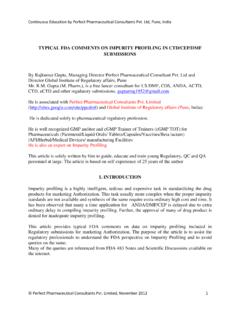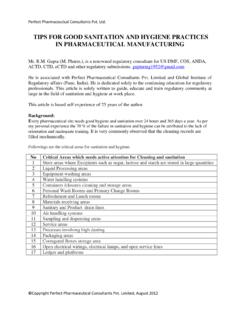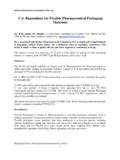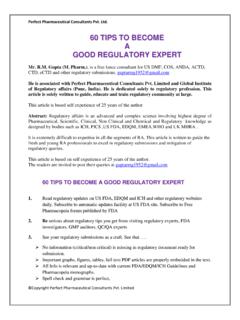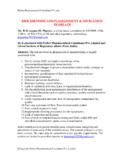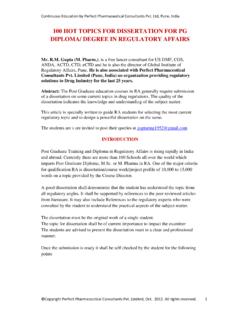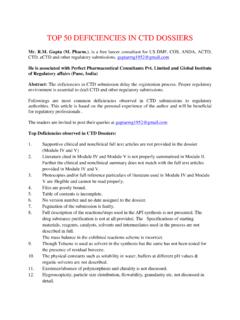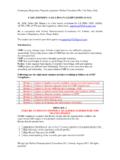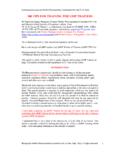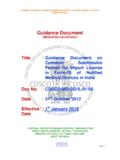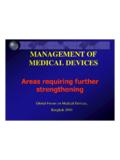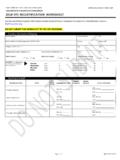Transcription of US DMF Type III for Fiber Board Drums - Medical …
1 Continuous Regulatory Education Program from Perfect Pharmaceutical Consultants Pvt. Ltd (India) Copyright Perfect Pharmaceutical Consultants Pvt. Limited, August 2012. All rights reserved US DMF* TYPE III FOR Fiber Board Drums FOR PHARMACEUTICAL PACKAGINGS Mr. Gupta (M. Pharm.), is a free lance consultant for US DMF, COS, ANDA, ACTD, CTD, eCTD and other regulatory submissions. He is associated with Perfect Pharmaceutical Consultants Pvt. Limited and Global Institute of Regulatory affairs (Pune, India). He is dedicated solely to regulatory profession. This article is solely written to guide, educate and train regulatory community at large. This article is based self experience of 25 years of the author in serving Flexible packaging Industry for meeting their US DMF Type III Registrations and Facility Audit SUMMARY: The Fiber Board packaging materials are largely used in Pharmaceuticals for packaging API, Intermediate and excipients.
2 US regulations under CFR 49 have prescribed a set of specification for controlling the quality of such packaging materials. US FDA offers registration of Fiber Board packaging materials under US DMF Type III. A very large number of Indian Companies have upgraded their site to meet US FDA requirements and have applied for US DMF. This article is written for the guidance of manufacturers and users of Fiber Board packaging materials The author has personal experience for filing US DMF Type III for Fiber Board Drums and other packaging materials for large number companies. 1. INTRODUCTION Fiber Board Container in context to Pharmaceuticals is rigid packaging structures used to package and protect bulk drug products, drug intermediates and excipients.
3 Fiber Board Containers are usually made from soft wood fibers. The container essentially includes following components: Multilayer Kraft Paper body Bottom and Top Plywood platform Metal rings with clippers for joining container body with top and bottom support The outer surface of the container is laminated, varnished and printed suitably. According to one estimate more than two-thirds of all bulk drugs and excipients in the world are packaged and transported in Fiber Board Drums or fiberboard IBC. The most common examples of Fiber Board Containers are: Round Drums and Square Boxes The identification code for a Fiber Drums under UN classification is: 1G. Continuous Regulatory Education Program from Perfect Pharmaceutical Consultants Pvt.
4 Ltd (India) Copyright Perfect Pharmaceutical Consultants Pvt. Limited, August 2012. All rights reserved 2. ADVANTAGE OF Fiber Drums 1 Full UN approval for packaging groups II and III (solids) 2 Re-useable, re-cyclable and thermally recoverable (100% recyclable) 3 Volume range up to 170 Liters 4 Resalable and tamper evident 5 Light and very strong 6 Full mouth opens affording the facility for filling and emptying without difficulty. 7 Sides can be Painted, Waxed, Monogrammed and Varnished. 8 Locking Ring provided with locking and sealing arrangement to prevent pilferage. 9 Top and Bottom are of hot pressured plywood, giving rigidity to the Drums . 10 Airtight 11 Availability in different sizes to suit specific requirements 12 Customizable to suit shipping requirements 13 Suitable for a wide range of drug products 14 Economical and lighter packaging 15 Easily disposed / recycled 16 High performance in terms of strength and durability 17 Great resistance to mechanical stress (stacking, static or dynamic vertical and radial compression, impact) 18 Electrostatic inertia and thermal insulation 19 Protection from UV radiation 20 Ease of use.
5 The fully-openable top ensures quick filling and dispensing 21 Easy to dismantle for recycling 22 It ensures economy in shipping cost (less weight, compact) 23 Volume range up to 170 Liters 24 Resalable and tamper evident 25 Light and very strong 26 Pilferage Proof 3. COMPOSITION OF Fiber Board Drums Design of Fiber Drums : The body of the Drums must be constructed of multiple plies of heavy paper or fiberboard (without corrugations) firmly glued or laminated together and may include one or more protective layers of bitumen, waxed Kraft paper, metal foil, plastic material, or similar materials. Top and bottom of the containers must be of natural wood, fiberboard, metal, plywood, plastics, or other suitable material and may include one or more protective layers of bitumen, waxed Kraft paper, metal foil, plastic material, or similar materials.
6 The body and heads of the drum and their joints must be of a design appropriate to the capacity and intended use of the drum . The assembled packaging must be sufficiently water-resistant so as not to delaminate under normal conditions of transport. Continuous Regulatory Education Program from Perfect Pharmaceutical Consultants Pvt. Ltd (India) Copyright Perfect Pharmaceutical Consultants Pvt. Limited, August 2012. All rights reserved REQUIREMENTS FOR Fiber Board DRUMSAS PER US FDA CFR 49 Standards for Fiber Drums 1 The identification UN code for a Fiber drum is 1G. 2 Construction requirements for Fiber Drums are as follows: 3 The body of the drum must be constructed of multiple plies of heavy paper or fiberboard (without corrugations) firmly glued or laminated together and may include one or more protective layers of bitumen, waxed Kraft paper, metal foil, plastic material, or similar materials.
7 4 Heads must be of natural wood, fiberboard, metal, plywood, plastics, or other suitable material and may include one or more protective layers of bitumen, waxed Kraft paper, metal foil, plastic material, or similar material. 5 The body and heads of the drum and their joints must be of a design appropriate to the capacity and intended use of the drum . 6 The assembled packaging must be sufficiently water-resistant so as not to delaminate under normal conditions of transport. 7 Maximum capacity of drum : 450 L. 8 Maximum net mass: 400 kg TEST PROCEDURES FOR Fiber Board Drums : (Reference: CFR 49) Fiberboard may be conditioned for at least 24 hours in an atmosphere maintained as per below: (1) At 50 percent 2 percent relative humidity, and at a temperature of 23 2 C (73 F 4 F); or (2) At 65 percent 2 percent relative humidity, and at a temperature of 20 2 C (68 F 4 F), or 27 C 2 C (81 F 4 F).
8 Drop test ( ) Fiberboard container must be filled with a solid material to not less than 95 percent of their maximum capacity; the contents must be evenly distributed. Test method: Samples of the filled Drums must be dropped onto a rigid, non-resilient, smooth, flat and horizontal surface. The point of impact must be the most vulnerable part of the container being tested. Following the drop, the container must be restored to the upright position for observation. Drop tests are to be performed with the solid to be transported or with a non-hazardous material having essentially the same physical characteristics. The specific gravity of a substituted non-hazardous material used in the drop test must be similar to the drug/excipients intended for transportation.
9 Criteria for passing the test: For all design types , there may be no damage which renders the container unsafe to be transported for salvage or for disposable, and no loss of contents. Continuous Regulatory Education Program from Perfect Pharmaceutical Consultants Pvt. Ltd (India) Copyright Perfect Pharmaceutical Consultants Pvt. Limited, August 2012. All rights reserved Stacking test ( ) Number of Packages Tested 6 Test Duration The stacking test load was applied to the top of the packages by loading each package with predetermined weight for 24 hours Passing criteria: No test sample may leak. There must be no leakage of the filling substance from the inner receptacle, or inner packaging. No test sample may show any deterioration which could adversely affect transportation safety or any distortion likely to reduce its strength, cause instability in stacks of packages, or cause damage to inner packaging s likely to reduce safety in transportation.
10 Vibration Test Number of Packages Tested 6 Rotary vibration table/Vertical vibration table at well defined Hertz and rpm Duration 1 Hour Passing criteria: A packaging passes the vibration test if there is no rupture or leakage from any of the packages. No test sample should show any deterioration which could adversely affect transportation safety or any distortion liable to reduce packaging strength Note: All the tests are performed on filled packages. The packages were filled to a minimum of 95% full. 95%of Maximum Capacity of test packaging T= {(F-W) x .95] + W T = Test Mass, F = Mass of package when filled to 100%, W = Tare weight of all packaging materials For all testing the packages were conditioned in accordance with 49 CFR (d) to 50% RH +/- 2% at 23 C for 24 hours or 65% RH +/- 2% at 20 C for 24 hours.}
